Several loads act on the roof of the house, which are calculated separately, but then they must be summed up. These are snow and wind loads, the weight of the roofing material, the weight of the actual rafters, lathing, as well as the underlay roofing carpet, insulation, etc. Therefore, the calculation rafter system roofs are carried out taking into account all loads. Let's analyze each of them separately.
Some introductory information
If you are engaged in construction on your own and do not quite know the engineering calculations, you can order the calculation of rafters in a specialized design organization or a private designer. If technical calculations are not alien to you, you can try to make calculations on your own. The answer to the question - how to calculate the length of the rafters correctly - depends on the shape of the roof and the angles of the roof slopes.
At the very beginning, you need to familiarize yourself with the regulatory documents. In order to calculate the load on the roof, you need SNiP 2.01.07-85 "Loads and Impacts", as well as maps that are attached to the document "Changes to SNiP 2.01.07-85", which came into force in 2008.
The optimal distance between the rafters is determined by the method of the limit, upon reaching which, the structure can collapse partially or completely.
Destruction of the rafter system
- The first is complete destruction or maximum load.
- The second is partial destruction, in which various units or elements of the system fail. In particular, the permissible deflection of any element, legs, braces, purlins, etc. cannot be more than 1/200 of the span or purlin.
You need to calculate both options. By the way, a good helper is a program for calculating the rafter system, it is made in Excel and.
For the northern, northwestern and central regions of Russia, heavy snowfalls are common, so you should approach the calculation very carefully. The full weight of the snow cover is taken to calculate the maximum load. For the second calculation, the total weight of the snow cover is taken into account with a factor of 0.7.
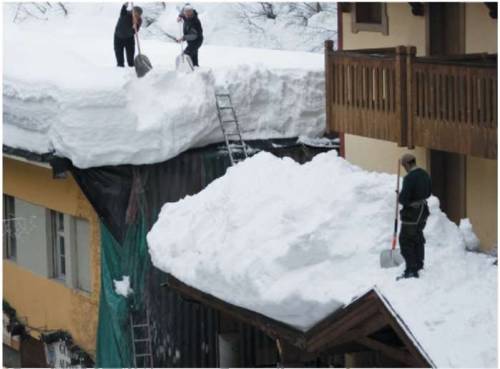 Snow accumulated on the roof
Snow accumulated on the roof Most often, snow accumulates in places where the roof is broken - valleys, outlets of dormer windows, etc. In such places, the pitch of the rafters should be minimal, mainly paired rafters are placed there. In addition, continuous lathing and double waterproofing are always made here.
The snow "bag" under its own weight will gradually creep down and forcefully press on the eaves overhang, therefore, the permissible output of roofing material given by the manufacturer must not be exceeded.
To calculate the snow load, depending on the direction of the prevailing winds and the slope of the roof, a special coefficient (m) is taken into account. Since there will be less snow on the upwind side of the slopes than on the ground, and more on the leeward side. For example, how to calculate the rafters if the house has a gable roof with angles of 20-30 °? To calculate the snow load at such angles, on the windward side, the coefficient will be 0.75, and on the leeward side - 1.25. All values \u200b\u200bof this coefficient are given in SNiP 2.01.07-85. For roofs with angles of 60 ° and higher - this coefficient is not taken into account, because snow does not linger on such roofs. Thus, to calculate the total snow load Q1, we need to use the table from SNiP 2.01.07-85 and the calculation formula: Q1 \u003d m * Q, where Q is the total snow load from the table, and the coefficient (m) is calculated using interpolation for different angles (for 20-30 ° m is 1, and for 60 ° m is 0).
To calculate the standard snow load Q2, you can use the atlas from "Amendments to SNiP 2.01.07-85" or the formula: Q2 \u003d 0.7 * Q * m
There is an additional correction factor, C \u003d 0.85, which applies to areas where snow is blown away by the wind. The wind should have an average speed above 4 m / s, and the roof should have an angle of 12-20 °. But at the same time, the average monthly temperature of the winter months should not be higher than -5 ° C, because in this case the ice that forms will not allow the wind to blow snow off the roof. And also if the building is being built in a forest or surrounded by other houses. The average daily temperature and wind speed can also be viewed on the maps in "Amendments to SNiP 2.01.07-85".
So, the dimensions of the rafters should take into account the snow load in 2 options:
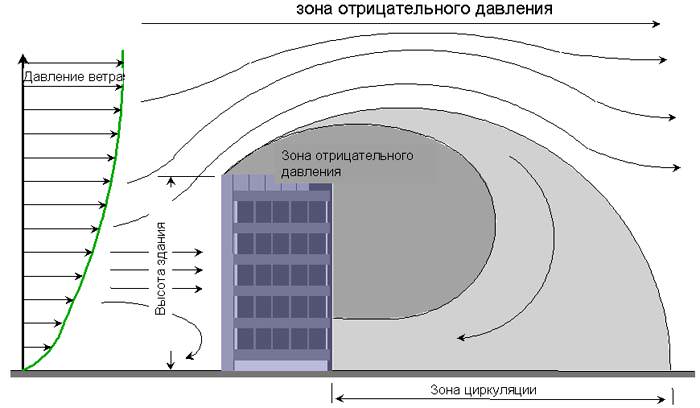 Impact of wind force
Impact of wind force Unlike the snow load, which seeks to destroy the roof, the wind load, in addition to destruction, can also tear the roof off the house, due to the aerodynamic force. The greater the angle of the roof slope, the greater the load it will experience from wind pressure. The smaller the angle, the more the lifting force will act, which will tend to carry the roof away.
How to calculate the length of the rafter leg one pitched roof? From the school geometry course, we remember the Pythagorean theorem, in our case the legs are the width of the building and the height difference between the walls, and the length of the rafters is the hypotenuse.
It is much more difficult to calculate the required section of the rafters and the distance between them. For this, we will consider the resistance to wind load. We use the formula: Wр \u003d W * k * C, where W is the wind pressure, which can be viewed in the tables of SNiP 2.01.07-85. K - coefficient, which depends on the height of the building, is given in the same regulatory document. C is the aerodynamic coefficient that is used to calculate the lift acting on the windward and leeward slopes. It can be positive or negative. Positive - when the wind presses on the surface of the slope (for large angles), negative - when the air flow "flows" from the slope (for flat roofs).
In order to counteract these efforts in the walls of the house, depending on what will be the step of the rafter legs, metal pins - "ruffs" are installed. Rafter legs are tied to them with wire twists through one, and if the house is being built in an area with strong winds, then each. For brick houses, as well as houses from silicate or foam concrete blocks, reinforcing belts of concrete are made, in which anchors with wire twists for rafters are laid.
Roof weight load
The own weight of the roofing material has a serious impact on the calculation of the rafter leg. For example, it weighs a lot compared to. It is known that the heavier the roofing material, the greater the angle of inclination of the roof. The load that will press on the roof can be calculated knowing its characteristics given in the technical data of the coating manufacturer. The table shows approximate weights different types roofing materials for 1 m² of roof area.
 Correspondence table of roofing materials to roof slope angles
Correspondence table of roofing materials to roof slope angles  Correspondence table of the pitch of the rafters, the materials used
Correspondence table of the pitch of the rafters, the materials used Depending on the type of roofing material, a certain type of batten is used, which you will fill for it. It is known that board, plywood, OSB board can be used for lathing. The average weight of each of these materials can be found in the table. For example, wooden blocks with a section of 6x6 or 4x6 cm are used for slate, and plywood or OSB boards are used for bituminous shingles.
What distance should be between the rafters can be taken based on the thickness of the material that you will be using.
The next calculated value will be the weight of the insulation, hydro and vapor barrier layers, as well as the inner cladding, if we are talking about a roof with an attic. The required thickness of the insulation is calculated by the formula: T \u003d R * l, where l is the thermal conductivity coefficient of the insulation, which can be viewed in the normative document SNiP II-3-79 " Construction heat engineering"Or in the manufacturer's technical data, and R is the thermal resistance building structure, which is planned to be insulated.
For example, the calculation of the truss structure, the trusses of which we plan to insulate with URSA M-20 glass wool in the Central Region, will include the following calculation of the thickness of the insulation: T \u003d 4.7 * 0.038 \u003d 0.18 m, where 4.7 is thermal the resistance taken by us from SNiP II-3-79, and 0.038 is the thermal conductivity coefficient specified by the manufacturer. Further from technical characteristics material we take its density 18-21 kg / m² and the upper value calculate the weight of 1 m² of insulation. In the same way, we find the weight of the waterproofing and finishing materialif we count a roof with an attic.
In addition, you need to take into account the own weight of the rafter structure. To do this, you can draw a plan of the rafters to represent what elements are expected to be used. The average values \u200b\u200bfor girders and layered rafters are taken into account - 5-10 kg per 1 m², and for hanging ones - 10-15 kg per 1 m².
All received loads are added and multiplied by a factor of 1.1 in order to have a safety margin. We will give an example of calculating the rafter system in the next article "".
You can additionally watch the theoretical foundations of calculations in the video:
Few will have to explain how important the roof of a house is. The roof should not only protect a country house from adverse natural phenomena, but also play one of the defining roles in the complex aesthetic perception of the building. Shape, color, proportions - all these will affect the exterior of the house. And on how well the truss system (the skeleton of the future roof) was designed, its strength, practicality and cost will depend.
Many professional architects prefer to design houses in the AutoCAD program, but when they come to designing a rafter system, their life turns into a constant nightmare, especially if the client is constantly making some changes and clarifications.
Many builders of low-rise buildings prefer to communicate with their clients without intermediaries, but when it comes to how the roof of the future cottage will look like, the customer gets nervous, because he cannot imagine his house completely, and the construction specialist makes a helpless gesture, because he does not have enough time or desire to spend a lot of energy to deal with professional software for designing and visualizing houses (such as: AutoCAD, Archikad, 3D Max, K3-Cottage, etc.). But there is a way out - this is the Arkon program. This product has already proven itself well in the Russian market. The program is especially good for sketch design country houses in particular, it has functions for the fast and efficient design of roofs and truss systems. Arkon software is successfully used by architects, builders, and even private users to design small houses.
How does the Arkon program work? The program allows the user to select the desired type of roof, and then make the necessary adjustments to the structure, i.e. you don't need to draw a rafter system from scratch! In particular, the following roof types are presented: free-form, pitched roof, gable roof, hip roof, half-hipped roof, mansard roof with gable, mansard-hip roof, spherical roof, gable roof with fastening rail, flat roof. Various combinations of roof types are also possible. In addition to the standard types, you yourself can design the roof that suits you.
![]()
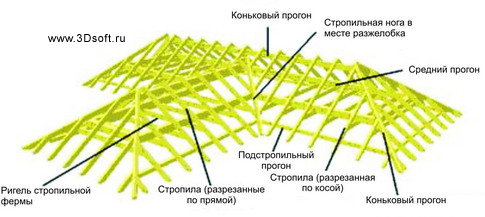
ArCon allows you to independently select the roof entry mode. You can use the function Roof installation and in the corresponding dialog box, set the basic parameters of the future roof and save them as standard.
Or use the window Roof editor and enter all the required parameters.

Using the Roof Editor, you can modify a typical roof shape. For this, individual values \u200b\u200bare entered for the individual roof slopes. For example, you can set gables, gutter heights, change roof slopes, etc.
By clicking the button View, you will immediately see the results of your changes, which, you see, is very convenient, especially when designing complex roofs.
By clicking the button Infoyou get a window Roof information... It shows all the lengths and areas of the wooden structure of the current floor, separately from the main roof and skylights. Costs and estimates are based on these values. All displayed values \u200b\u200bare calculated automatically based on the designed 3D roof model, i.e. the possibility of errors in calculations is excluded.

The roof system and the house are structures that complement each other. A home without a roof is a defective home. As for the roofing system, it cannot be built without a supporting structure. For the correct construction of the roof, the design of the future project and the calculation of the system are always carried out. In the photo you can see an example of calculating the rafter system.
The calculation in this case is mandatory. Here it is necessary, as they say, to measure seven times and cut off once. In no case should you deal with the construction of the roof with information made by eye. During its construction, the developer must take into account the future loads of the roof (read: "").
Loads can be:
- Variables, for example, the ingress of various kinds of precipitation (rain, snow, sleet with rain, etc.);
- Permanent, that is, the weight of the roofing itself, the battens, waterproofing, various parts of the pie, etc. In addition, in this case, the weight of certain equipment is taken into account, which will also be installed on the roof.
- Special ones like strong winds, hurricanes, etc. Typically, such loads can occur in seismically hazardous areas. As for a strong gusty wind, it can occur absolutely in any area.
How to calculate a roofing pie scheme
Calculating the load on the rafters is not so difficult to do. To do this, you can compose simple scheme, in which you need to designate all the elements of the roofing system. Usually it includes roofing material, lathing, counter-lathing, hydro-barrier, insulation, vapor barrier and, for example, drywall as a finishing material.
All of the above elements give a certain load to the roofing system. Rafters generally have to withstand such a load for many years.
We make a calculation with a correction factor. It turns out: 180 x 0.7 \u003d 126 kg of snow per 1 sq. m. Here is the calculation of the snow load on the roofing system.
Calculation of wind loads
Wind loads are calculated using the following formula: W \u003d Wo x k
- Wo is a normative indicator. It is determined by the table, each area of \u200b\u200bthe area, as a rule, has its own table;
- k is a correction factor. It allows you to determine the change in wind load, which changes according to the type of terrain and the height of the building.
Pay attention to the following table. The letter "A" in it denotes an open type of terrain, that is, the coast of seas, lakes, steppe. The letter "B" denotes areas with obstacles, that is, forest, city buildings.
| House height, measured in meters | AND | B |
| 20 | 1,25 | 0,85 |
| 10 | 1 | 0,65 |
| 5 | 0,75 | 0,85 |
We calculate a house 5 meters high. It is located again in the Moscow region, in a wooded area. According to the wind load indicators, the house is located in the 1st type of region, where the load is 23 kgf / sq. m.

We make a calculation with a correction factor, it is 0.5. Thus, we get 23 x 0.5 \u003d 11.5 kgf / sq. m. This will also be an indicator of the wind load.
Calculation of the cross-section of rafters and other roofing elements
Calculation of the rafter system gable roof implies taking into account many roofing elements that are not similar to each other. First of all, before you need to decide on roofing material and its purpose, to determine the type of attic floors, which are usually reinforced concrete or wooden.
When choosing a section of a bar, the following points must be taken into account:
- the length of the rafters;
- installation step of structures;
- calculations of the magnitude of the loads.
| The step with which the rafters are installed (cm) | Rafters length (meters) | ||||||
| 3,0 | 3,5 | 4,0 | 4,5 | 5,0 | 5,5 | 6,0 | |
| 215 | 100x150 | 100x175 | 100x200 | 100x200 | 100x250 | 100x250 | - |
| 175 | 75x150 | 75x200 | 75x200 | 100x200 | 100x200 | 100x200 | 100x250 |
| 140 | 75x125 | 75x175 | 75x200 | 75x200 | 75x200 | 100x200 | 100x200 |
| 110 | 75x150 | 75x150 | 75x175 | 75x175 | 75x200 | 75x200 | 100x200 |
| 90 | 50x150 | 50x175 | 50x200 | 75x175 | 75x175 | 75x250 | 75x200 |
| 60 | 40x150 | 40x175 | 50x150 | 50x150 | 50x175 | 50x200 | 50x200 |
Other elements of the roof can have a different cross-section of the timber. It is individual for each element:
- mauerlat: 100x100, 100x150, 150x150;
- runs: 100x100, 100x150, 100x200;
- diagonal legs, valleys: 100x200;
- struts: 100x100, 150x150;
- crossbars: 100x150, 100x200;
- hemming boards: 25x100;
- puffs: 50x150.
After the calculation of the rafters of the gable roof has been made, that is, their length, section, and their location step have been found out, you can find out how many rafters are required. To do this, you need to focus on the length of the house. The rafter system of the hipped roof is also calculated.
During design, it is also necessary to perform a deflection calculation. In this case, firstly, the load of the rafters is determined, and secondly, the possible deflection of wooden beams (read: "").
If we mean for mansard roof, then the amount of deflection should not exceed 1/250 of the length of the section on which the pressure is applied.
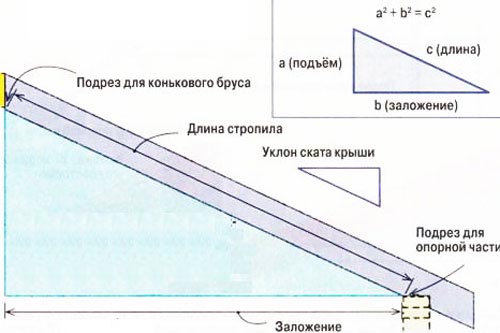
If you use rafters 5 meters long, then the maximum deflection can be no more than 2 centimeters. If its value is higher, then in the future it is possible to clearly observe the deformation of the roofing system.
Thus, we can conclude that the calculation of roof rafters is not a particularly difficult task.
What quality should the roofing material have?
The rafter system of a gable roof calculation depends mainly on the type and quality of the roofing elements. So, the calculation of the rafter leg should be made in accordance with the type of material from which it is made. After all, many do, for example, the calculation of metal rafters, since for one reason or another they do not want to buy wooden structures... In any case, the service life of the house depends on the quality of the material and the correctness of the calculation of the roofing system.
As for wood rafters, according to GOST 2695-83 and GOST 8486-86, this material must meet the following requirements:
- 1 meter of rafters should not have more than three knots, their length should not exceed 3 centimeters;
- the material may have blind cracks, but they should not exceed ½ of the length;
- the moisture content of the rafter should not exceed 18%, usually this indicator is measured using a moisture meter.
When buying rafter materials, you must familiarize yourself with their SNIP data. It contains information about the manufacturer, product name, standard number, type of wood, product size, moisture level indicator, number of products in a package, production date.

It is worth noting that a tree is natural material, therefore, before starting work, it must be treated with special antiseptic, flame retardant and bioprotective agents. They will protect wood from decay, insects, fire, that is, increase its performance and service life.
Then, they usually begin the structural work of the rafters. In this case, a waterproofing system is laid in the place where the brick is in contact with the wood structure. After the waterproofing is laid under the roofing material, a vapor barrier material is laid in front of the insulation layer. At the end, they are engaged in the equipment of ventilation of the roof space.
If you follow all the rules for the construction of the rafter system wooden housethen it will serve you long years without annual restoration work.
Programs for the design and calculation of roof systems
From all of the above and the above, we can conclude that the design of any rafter system includes a lot of complex work that requires some experience and knowledge. Only experienced craftsmen should be engaged in such work.
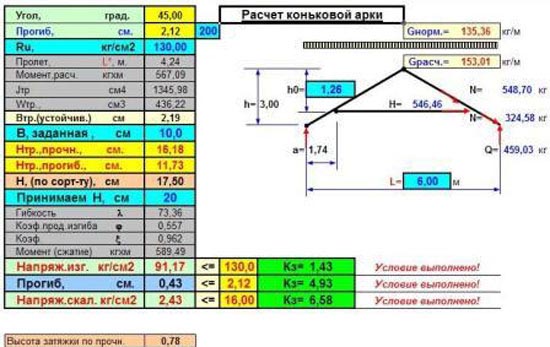
As for the design of the roof, today special programs have been developed that are available to everyone. These computer programs will help you design any building element. Such a program for calculating the rafter system can help to make a quick and correct calculation of the rafter system of a gable roof (more: ""). If it is necessary to calculate the rafter legs of a brick, wooden house, then this program will perfectly help every designer.
One of the most famous and understandable programs in this regard is the Arkon program. She will help with calculations not only for professionals, but also for beginners.
Posted on 04/07/2017
Creating a project and calculating a rafter structure is far from an easy task. A person without minimal experience and knowledge is unlikely to cope with this issue on his own. First of all, all the complexity of the calculations lies in a large number of certain factors that affect the roof structure - this is the load from snow and wind, and the total weight of the roof, and much more.
Therefore, if a person is not sure of his capabilities, then it is advisable to contact specialists or use computer programs that facilitate the calculation procedure. After all, it's not a secret for anyone that the further comfort of all inhabitants of the house will depend on the correct construction of the roof.
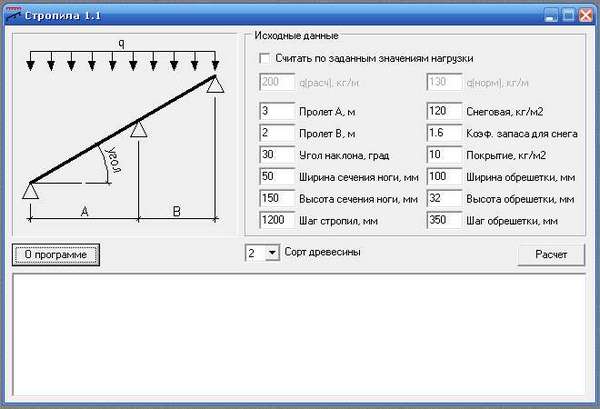
Most often, the rafter system is constructed during the construction of private houses. The basis of most of these roof structures is a system of wooden beams repeating a triangle in shape.
It is this shape of the roof that is considered the most rigid and durable, and the resulting space between the roof and the ceiling forms attic, which is very often used as an attic or a warehouse for old things. Also, by changing the shape of the rafter system, instead of an attic, you can get another room used as an office or an additional living room.
Factors to consider when calculating
Before proceeding directly to the calculations of the rafter structure, it is necessary to determine what loads and with what intensity will act on it, depending on the climatic characteristics of the region and the time of year at the place of construction of the house. Moreover, the main natural factors affecting the roof can be classified according to the following parameters:
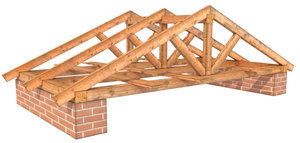 1.
Constant load on the rafters. This category includes all external influences on the rafters, which have a constant value - this is the mass of the roof, waterproofing, lathing, insulation and other structural systems, depending on what type of roof was used, single-slope or gable, that is, all elements that create a constant load with fixed mass.
1.
Constant load on the rafters. This category includes all external influences on the rafters, which have a constant value - this is the mass of the roof, waterproofing, lathing, insulation and other structural systems, depending on what type of roof was used, single-slope or gable, that is, all elements that create a constant load with fixed mass.
2. Loads with variable impact on rafters. TO this kind external factors due to climatic characteristics can be enumerated: rain, ice, snowfall, intensity and gusts of wind and much more.
3. Specific loads - weather and natural factors with maximum intensity. This parameter is especially relevant in places with high seismic activity, strong gale winds, tornadoes and hurricanes.
The difficulty of calculating the rafter system is that it is very difficult for most newcomers to the construction business not to miss one of the many types of loads listed above that simultaneously affect the roof of the building. This is also due to the fact that in the calculations it is necessary to take into account the strength and mass of the rafter legs themselves and the method of their installation and fastening to each other. Although these parameters are secondary, they are no less important and it will be unforgivable to miss them in the calculation.
Therefore, to help novice builders, a special program was developed for calculating structures, although you can use standard formulas, it all depends on the preferences of the person conducting renovation work... Moreover, very often it is manual calculation and analysis that helps to understand all the features of the rafter design.
How is the permanent load on the rafter system calculated?
In order to correctly determine the length of the timber for the rafters and the data on which the basic calculations will be based in the future, first of all, you need to calculate the total mass of the roofing "pie".
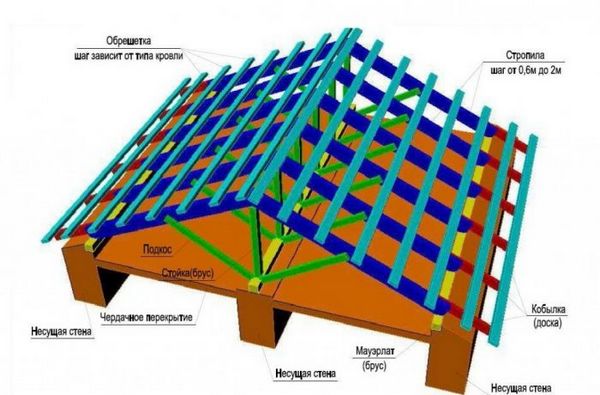
To obtain final results, it is necessary to calculate the mass of one square meter a single layer of the roof. In this case, you need to be guided by the fact that the average roof consists of the following structural elements:
Lathing, which consists of small wooden blocks or boards, 25 mm thick. At the same time, the average weight of a square meter of standard crate varies within 15 kg.
A layer of insulating material.
Roof waterproofing.
The material used as the main roof covering.
When calculating the total mass of a constant load, the final result, according to the advice of professional builders, must be increased by 10%, which will make it possible to make the necessary margin of safety for the future rafter system.
Also, according to the recommendations of professionals, the material of the roofing "pie" should be chosen in such a way that the total load indicators ultimately do not exceed 50 kg per square meter of the roof. Many consider such a load to be too high, but it should be understood that an additional margin of safety is never superfluous. Having completed the calculations of the total mass of the roof, they proceed to calculate the load from natural factors.
Calculation of snow loads on the rafter system
The parameter of snow load is quite relevant for our climatic conditions, since most regions have a long winter period with constant precipitation. So that the roof does not deform, and even worse breaks under the weight of the snow layer, it is necessary to lay additional strength in the rafters at the planning stage even at the planning stage.
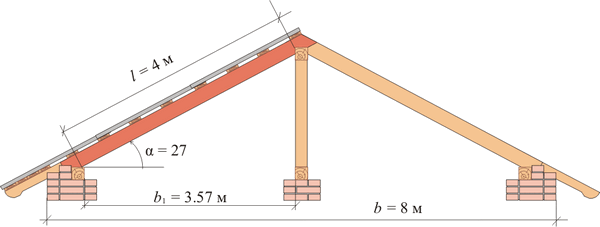
To make the calculations not so complicated, a generalized formula was derived, which is based on the substitution of coefficients from SNiP. In practice, this formula looks like this: F \u003d P × k, where F is the total load from snowfall, P is the mass of the snow layer per square meter of the roof, k is the correction factor, which is based on specific factors and design features of the roof.
The mass of a square meter of snow depends on the location of the erected structure. All regions of our state, depending on the intensity of snowfall, are subdivided into certain zones with their own average indicators. At the same time, the SNiP provides correction factors for each individual roof structure. I would also like to note that this coefficient directly depends on the slope of the roof slope:
When the slope of the roof is more than 60 °, then the correction factor is not used, since with such a slope the snow simply does not linger on the roof;
If the coefficient of the angle of inclination of the roof ranges from 25 to 60 °, this coefficient is 0.7;
A roof with a minimum practically gentle slope has a maximum correction factor equal to 1.
Do not forget that the load from the snow cover on the rafters may not be entirely uniform, since the maximum amount of snow accumulates in the places of fractures of the roof structure and other structural elements of the roof. Rafter legs in such places should have a minimum step relative to each other - the use of a paired element is considered the most effective option. In addition, forming a roofing "pie", in potentially problematic areas, double waterproofing and solid sheathing are installed.
Calculation of the wind load on the rafter system
This type of load is characterized by a high level of criticality, since regardless of the angle of the roof slope, it is subject to risks from the effects of sudden gusts of wind. With a minimum slope ratio, the roof may tear off due to the influence of aerodynamic forces. And with a strong roof slope, the maximum air flow pressure occurs over the entire area of \u200b\u200bthe roof structure.
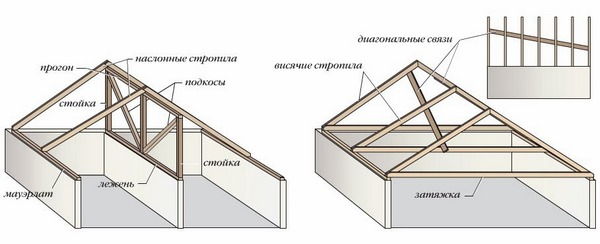
To calculate the wind load on the rafters, a formula was also developed taking into account the correction factor, which in practice looks like this: V \u003d R × k, while V is the direct value of the wind load, R is the indicator responsible for the region where the structure is located, k is the correction factor, as in the case of snow loads.
The regional parameters mean the data given in SNiP, and the correction factor means indicators that take into account the height of the building and the features of the area in which the building is located. Moreover, the value of the coefficient itself depends on the following factors:
For buildings with a height of 20 m, and the building itself is located in an open area, the correction factor is equal to 1.25, if there are artificial or natural obstacles on the territory (other buildings or a strip of trees), then the value decreases to 0.85;
For buildings with a height of 10 m, an amendment from 0.65 to 1 is used;
In turn, a correction factor from 0.75 to 0.85 is applied in the process of calculating the loads on houses less than 5 m in height.
Calculation of the structure of the truss and the parameters of the rafter legs
 To understand what is the calculation of the structure of the truss, you need to take into account the fact that in reality the rafter system is a set of triangles of wooden beams, so there should be no problems with determining the length of the rafters, since all mathematical actions are carried out at the level of school geometry.
To understand what is the calculation of the structure of the truss, you need to take into account the fact that in reality the rafter system is a set of triangles of wooden beams, so there should be no problems with determining the length of the rafters, since all mathematical actions are carried out at the level of school geometry.
However, for the correct calculation of the rafter structure, it is important to take into account all load indicators, as well as the size of the spans, the configuration of the lathing and the peculiarity of the type of the roof itself. To save yourself from additional mistakes and miscalculations, it is advisable to use special programs that can be found on the Internet.
To calculate the rafters, you must use special tables of standards. I would like to note that there are ready-made rafter legs that can be purchased in specialized hardware stores or in the markets. In this case, the length of the rafter legs will depend on the structural features of the structure, and the selection of the rafter section depends on the following parameters:
The length of the rafter legs;
The step with which the rafters will be mounted;
The magnitude of the known loads.
It is important to take into account that the parameters given in the recommendations are not absolute and may vary depending on the regional characteristics of the location of the room. And for the correct calculation of the rafter leg, the Pythagorean Theorem is used. In this case, the legs will mean the difference in height between the walls of the building and its width, and the hypotenuse will correspond to the length of the rafter.
The calculation of the rafters of any structure cannot be attributed to a simple task, for the simple reason that in order to obtain accurate data, it is not easy to correctly operate with the initial numbers and special formulas, and it is also easy to navigate in SNiP and have minimal drawing skills.
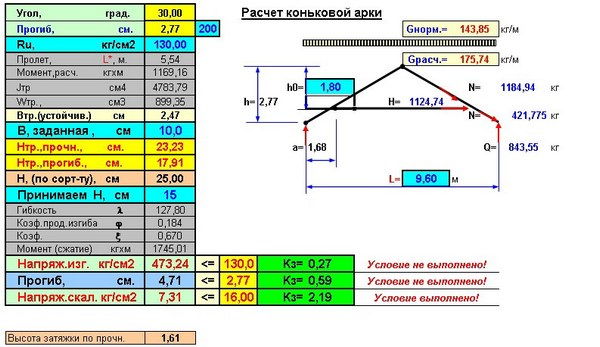
If the above skills do not match the abilities of the person performing the repair, then it is advisable to use free software that can be downloaded on the Internet.
A striking example of such an information product can be safely called the 3D Max program. At the same time, having minimal computer skills, any person can cope with the software without any problems. In addition, most programs have illustrative examples that make it easier to work with the calculation of the rafter system.
For people who are completely not versed in the intricacies of 3D design, you can download the free Arkon program, in which, in addition to the rafter design system, there is a calculator designed to calculate the parameters of rafter legs (section and length of a bar). In addition, the program has a simple, intelligently understandable interface that greatly simplifies the entire process of calculations. I would also like to mention the online services for calculating the structure of rafters, which do not require downloading programs.
| Discuss on the forum |
|
| |
|
One of the most important parts of a pitched roof is the rafter system, which consists of strong and reliable beams. It is the rafters that are the basis for the roof. At the same time, it is important that the materials used can easily withstand not only the roof structure, but also the pressure of snow or ice masses in winter, as well as wind loads throughout the year. In this regard, before proceeding with the installation of the rafters, the necessary calculations should be made, taking into account all possible factors and nuances. Of course, you can order a miscalculation of rafters in various construction companiesHowever, such a service will cost a pretty decent amount, so self-calculation may be the best option. So how to calculate the roof truss system correctly? Of course, before moving on to the main question, it is worth studying the features of the rafters and the types of construction.
Features of the rafter system
To make the calculation of the rafter system, you should understand what it is. So, the rafters are basic structure a roof that takes on all external loads, in the form of snow drifts, heavy rainfall or squall winds. Its main elements are:
- vertical posts - necessary for maximum stability of the rafter system;
- rafter inclined legs - determine the slope of the roof slope and its general appearance;
- girders - side and ridge varieties of girders are distinguished, elements are necessary to fasten and maintain the rafter legs;
- puffs, crossbars - fixing elements;
- struts - diagonal support beams that give stability to the rafters;
- ridge - an upper beam, laid at the junction of two roof slopes;
- filly - an element that allows you to increase the length of insufficiently long rafters in the case of installing a roof overhang;
- farm - a set of racks, braces, battens and other elements that make up the basis of the roofing system.
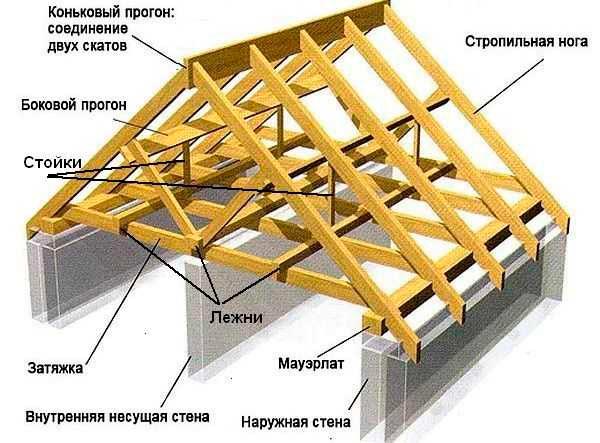
Starting to calculate the rafters, you should calculate each individual element. It is also important to comply with the requirements for the rafter system, this will help you choose the right material, as well as create the strongest and most durable roof.
Basic requirements when choosing a rafter material
Today, quite a few homeowners prefer timber roofs. As a rule, the truss system is made from coniferous trees. In this case, the timber should have a moisture content of no more than 20%. This is the so-called air-dry wood, which is characterized by the necessary strength and lightness. In addition to the percentage of moisture when choosing a tree, conditions such as:
- the presence of a minimum number of knots, cracks and other possible defects, for this it is worth choosing wood of 1 or 2 grade. When choosing a tree of 3 grades, you should pay attention that there are no more than 3-4 knots up to 3 cm high per 1 m of a board or bar, and if there are cracks, their length and depth should be small;
- for load-bearing, capital elements, such as rafter legs, mauerlat, ridge and so on, it is recommended to use a beam more than 5 cm thick, it is optimal to use products with a square or rectangular section from 10 to 20 cm;
- when choosing coniferous boards, the length of products up to 6.5 m is allowed, and if hardwoods are used, then the length of the lumber should not exceed 4.5 m. As a rule, hardwoods are used for such structural parts as purlins and mauerlat. It is also worth giving preference to hard rocks.

Important! The entire system to be built must have rigidity and strength. That is, the finished structure must have a secure fit and be motionless. If at least one element does not meet this requirement, then there is a high probability that the roof can be destroyed by a hurricane wind or heavy snowfall, and it will not matter how the wooden roof rafters are calculated correctly. In the most deplorable situation, not only the roof will be destroyed, but also the walls of the building. It should also be borne in mind that the rafter system should be made light, especially when wooden load-bearing walls... In order to be able to use strong and reliable beams, but at the same time not to burden the structure, it is recommended to choose lumber with a low percentage of moisture, that is, approximately 10-15%. Also, do not forget about the treatment of wooden elements with antiseptics, fire retardants, water repellents and other protective agents. Before proceeding with the question of how to correctly calculate the rafter system, you should get an idea of \u200b\u200bthe types of rafters.
Related videos:
Varieties of rafters
The specific type of rafters depends on the type of roof and, when calculating the rafter system, this should be taken into account. For example, the roof can be gable or hipped, respectively, and the rafters will be calculated differently. At the same time, the presence of structural elements and the principle of their installation remain practically unchanged. Today it is customary to distinguish 2 main types of rafter systems.
- Inclined rafters - in this case, the rafter legs rest on the walls of the building, and an intermediate support props up their middle. A similar system is mounted, if necessary, if spans are made longer than 5-7 m.Each additional support can increase the span length by 3-4 m.
- - installed when the distance between the outer walls, on which the rafter system is installed, is not more than 6.5 m.

Having chosen a specific type of roof, as well as a type of rafter system, you can proceed to performing all the necessary calculations, that is, calculating the rafter section, load, length and height of beams, and so on.
Calculation of the load on the rafters
When calculating the roof rafters on your own, it is recommended to take increased parameters, so that you can have a certain margin of safety for the roof. Of course, this will increase the consumption of building materials, however, home safety issues should still be put in the first place. So, the first step is to take into account all possible loads that will affect the roofing structure. In particular, such loads include snow and wind loads. Also, when calculating the load on the rafter system, it is worth considering quite a few features. Including factors such as:
- weight of roofing material;
- crate weight;
- the weight of the insulation, hydro and vapor barrier;
- weight of the rafter system.
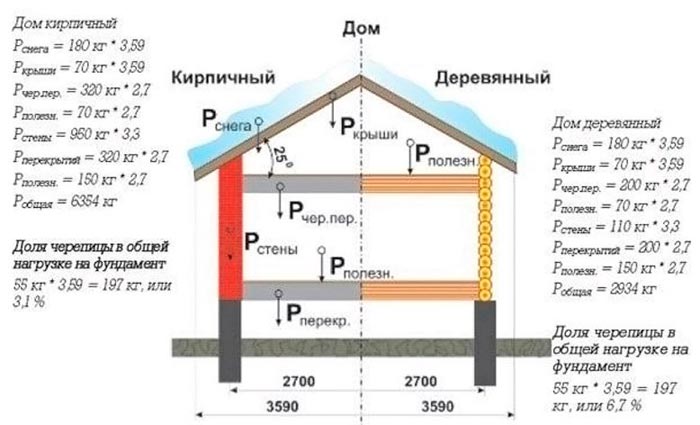
Only after calculating each point, you can calculate the rafter system. For example, the formula for calculating the snow load will look like this:
S \u003d Scalculated μ,
where S is the required parameter, Scalc. - the value of the weight of snow per 1 square meter, which should be taken from the SNiPs in force in a certain territory, and μ is the coefficient calculated from the angle of inclination of the roof. To calculate the wind load, you can also use the formula:
Wm \u003d Wo k c,
where Wo is the normative parameter of wind pressure, determined by SNiPs in force in the region, k is the coefficient of wind pressure, depending on the height of the roof above the ground, and c is the aerodynamic coefficient, which depends on the shape of the roof. Knowing all the initial values, it will not be difficult to make calculations. However, today it is not at all necessary to carry out all the necessary measurements and calculations manually. Indeed, for these purposes, special programs have been created, for example, a program for calculating a rafter system or a program for calculating rafters and trusses. These programs include:
- Stropila;
- AutoCAD;
- Arkon;
- Online calculation services (construction calculators).
How does this software work? It is quite simple, you need to enter all the parameters from SNiPs or the building plan in the appropriate windows or lines, then press the "calculate" button and the program will give the result. As a rule, these resources include all the necessary calculations, that is, wind and snow loads, as well as the calculation of the total load, the calculation of the distributed load, the calculation of the rafter system, and so on. Also in the programs there are maps with the value of wind pressure and the weight of snow cover in all regions. Even untrained users will be able to make calculations in such applications, and all parameters will be the most accurate. In addition, it should be borne in mind that certain parameters are constant and can be found in the instructions for building materials or on the Internet.
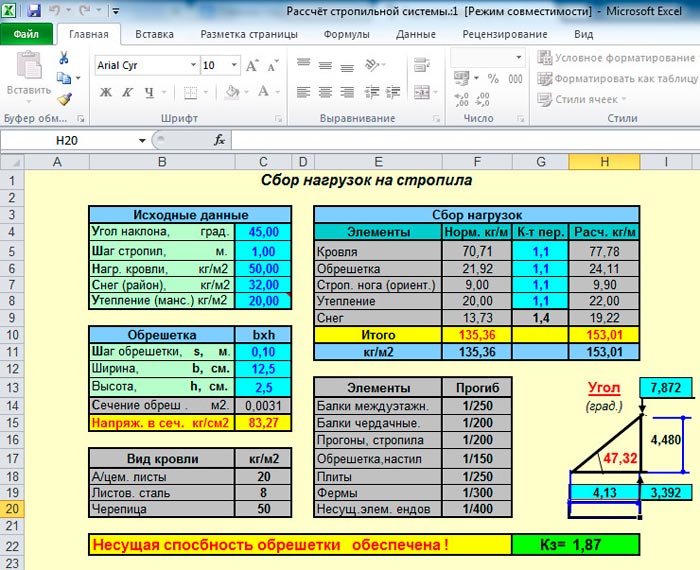
Roofing type and weight
Depending on what material is planned to be used for the roofing, the load on the rafter systems also changes. Almost all types of coatings have a fixed weight, making the calculation quite easy. Consider the weight value of the main types of roofing that manufacturers provide during their manufacture.
As for the mass of the rough flooring, rafter system and lathing, these values \u200b\u200bare considered to be standard. In particular, the rough roofing structure will have a weight of 18-20 kg / sq.m, wooden crate - 8-10 kg / sq.m and rafters - 15-20 kg / sq.m. By summing up all the values, you can easily find the desired parameter of the load on the rafter system.
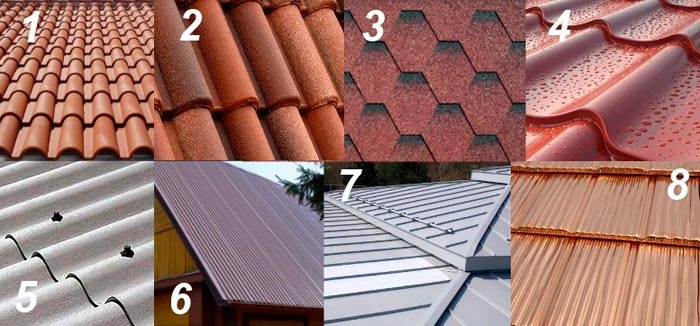
Calculation of rafters
After the load is determined, you can proceed to such an item as the calculation of the rafter system. It is necessary to determine the load on each rafter leg in order to understand what section the rafters should have, their strength and how much wood is required for the rafters in each case. The formula for calculating the load on each rafter leg is as follows:
Qr \u003d A Q,
where Qr is the required value, measured in kg / m, A is measured in meters and Q is the total load acting on 1 sq. m of the roof, measured in kg / sq. m (this value was found in the calculations performed earlier). It is also possible to calculate the load in an automated mode using programs. Various applications allow you to calculate the cross-section of the rafters, their number, height and many other parameters. Important! When calculating the rafter system, you should always round up the parameters upward, as this allows you to increase the strength of the roofing structure.

It is not at all difficult to make the necessary calculations yourself. Of course, if there is not enough knowledge in this matter, then you can always turn to specialists. However, a huge variety of automated programs can help you deal with the calculation of the rafter system without much hassle. It is important to remember that not only the strength and reliability of the roof, but also the safety of the residents of the house, depends on the correctness of the calculations.



